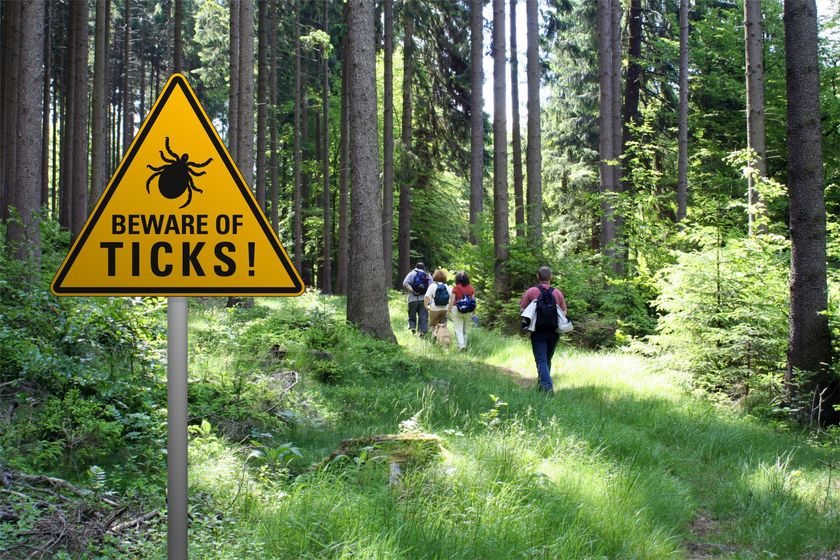- Sections :
- Crime & Public Safety
- Restaurants & Food
- Sports
- More
Tick Talk: How to prevent and treat bites this season

THE WOODLANDS, TX -- Springtime is a great opportunity to get outside and enjoy warmer weather. Unfortunately, ticks feel the same.
While ticks can be present in some regions year-round, their prevalence tends to peak in the warmer spring months and last through early fall. Human encounters with ticks have been on the rise for several years as warmer winters have led to larger tick populations and a broader reach for the insects.
There are an average of 85 confirmed and probable human cases of Lyme Disease in Texas each year, according to the Texas Department of State Health Services (TDSHS).
Outdoor enthusiasts should be aware of how to prevent, spot, and treat tick bites, as they can spread diseases such as Lyme disease and Rocky Mountain spotted fever.
“Tick bites are annoying at best and dangerous at worst,” said Dr. Phillip Lamptey, medical director for Memorial Hermann-GoHealth Urgent Care. “They can transmit numerous harmful diseases. But a few preventative steps can reduce risk. Knowing what to do if you have been bitten can lead to better outcomes.”
A few suggestions:
LEARN
Before you go, learn about the types of ticks in the area and the diseases they carry. In Houston, the Lone Star Tick is common; its irritating bites are linked to a variety of illnesses, including Alpha-gal syndrome, an allergy to red meat that can be life-threatening. The Black-Legged Deer Tick can transmit Lyme disease, while the American Dog Tick is known to spread tularemia and Rocky Mountain spotted fever. The Brown Dog Tick can also transmit Rocky Mountain spotted fever.
Ticks can be tiny and hard to see before they bite. Unfed nymphs are about the size of a poppy seed and unfed adults are the size of a sesame or apple seed.
Ticks can be found in numerous places outdoors – from backyards to deep woods. In general, they prefer shaded, grassy or bushy areas with lots of leaf litter. They attach to people or pets as they brush against vegetation. Once on the body, the tick will climb and look for a dark place to burrow. Common burrowing spots include on the scalp, at the waistband, under the arms or between the legs.
PREVENT
Choose light-colored clothing to make it easier to spot dark colored ticks before they bite. Wear long sleeves and pants and consider tucking pants into socks and shirts into pants to make it harder for ticks to reach your skin.
Treat clothing and gear with products containing 0.5% permethrin or buy pre-treated clothing. Consider using an insect repellent containing DEET on your skin.
Stay on trails and avoid tall grasses or other areas where ticks may be.
CHECK
When outdoors, do tick checks regularly by scanning arms and legs for climbing ticks.
After spending time outside, shower and change into clean clothes as soon as possible after returning home. Check for ticks that might have found their way to armpits, the groin, behind ears and other common burrow areas. Inspect gear and clothing for ticks when putting things away. Washing clothes in hot water or tumbling them in a hot dryer will kill ticks.
Don’t forget to check your pets! They can carry ticks and are susceptible to some tick-borne diseases, too. Check pets daily if they spend time outdoors. If you often hike or camp with your dog, ask your veterinarian about preventive medications.
REMOVE
If you do find a tick, remove it immediately. This goes for pets, too. The longer a tick is embedded, the greater the chance it can transmit disease.
“It's important to remove it quickly,” said Dr. Lamptey. “Avoid remedies like coating it with petroleum jelly, painting it with nail polish, or using heat or flame to get the tick out. These are not as effective as a good pair of tweezers and a steady hand, and they may cause more harm.”
Using clean tweezers, grasp the tick as close to the skin as possible and pull straight out using firm pressure. While there are tick removal tools, tweezers will do. Take care not to twist the tick during removal or crush it, as that may leave the burrowed head behind. If possible, place the tick in a sealed container or take a photo for identification in case of infection.
Clean the affected area with rubbing alcohol to remove bacteria and cover with a bandage. Wash your hands.
MONITOR
In many cases, tick bites are harmless, and no medical treatment is necessary.
However, after a tick bite watch for signs and symptoms of tick-borne diseases, such as fever, rashes, fatigue, headache, muscle pain, joint pain, or swelling. Keep an eye out for a red bull’s eye rash around the bite, red dots on the ankles and wrists, or any flu-like symptoms as these may be signs of Lyme disease.
Seek medical help if you are not able to fully remove the tick or if the bite shows signs of infection, such as oozing, swelling or discoloration.
If you live in an area where Lyme disease is common, talk to your healthcare provider. In certain circumstances, they will give you a single dose of antibiotics following a tick bite to lower your risk of tick-transmitted bacterial infection, including Lyme disease.
While ticks can be worrisome, knowledgeable health providers can help. Contact your healthcare provider with concerns.
“We love to see people live their best lives, so get outside and have some fun,” said Dr. Lamptey. “We are here to help if you need us.”



















